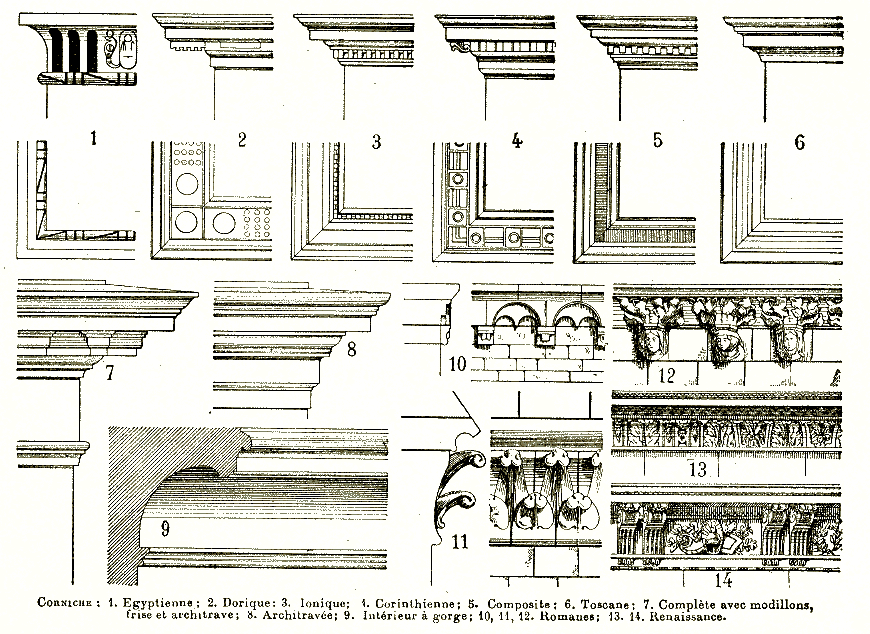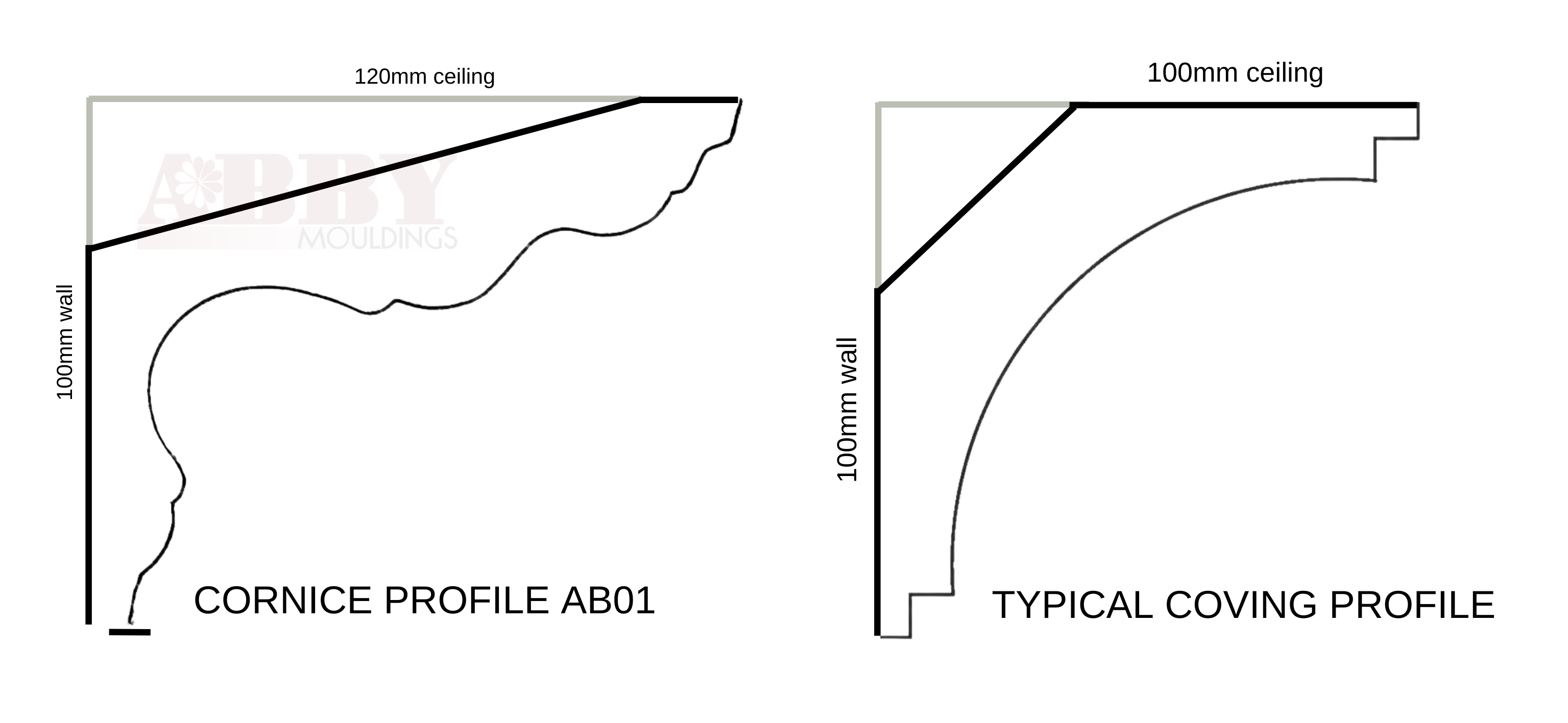A cornice refers to an architectural element that extends beyond the surface it rests on. Serving as the uppermost horizontal feature protruding over a wall or below a roofline, it played a prominent role in ancient Greek and Roman structures as the crowning part of the entablature. Traditionally composed of various components:
1. Cyma: A moulding characterised by its double curvature, often referred to as a ‘wave moulding.’ It assumes the highest position within the cornice and can adopt either a cyma rectum (with an upper concave curve and a lower convex curve) or a cyma reversa (with an upper convex curve and a lower concave curve) form.
2. Corona: This particular component boasts a vertical face and a horizontal soffit, contributing to the overall structure.
3. Bed-moulding: Positioned beneath the projecting cornice, a bed-moulding is a moulding that adds a finishing touch to the appearance.
While the primary function of cornices is to shield the walls of a structure by diverting rainwater away, it also holds considerable decorative significance. Beyond their practical role, cornices are widely employed in interior design. Acting as a form of moulding running along the top of interior walls, they serve multiple purposes. By reflecting light into shadowy areas, they can illuminate a room, creating a brighter ambience. Moreover, they possess the ability to visually expand small spaces by drawing attention upward. Additionally, they can be utilised to conceal any unsightly cracks that may emerge along the joint between walls and ceilings.

What sets cornice apart from coving?
When discussing artificial grass, we often throw around the term Astroturf, even though it is just one brand among many. Similarly, Hoover has become synonymous with vacuum cleaners, regardless of the actual brand. We tend to say, “I’m going to Hoover” instead of “I’m going to vacuum.” A similar trend has emerged with coving. The proliferation of cheap, mass-produced paper-coated strips in DIY stores and builder’s merchants has led to the misconception that all cornice is coving. However, there is a significant distinction to be made.
True cornices are meticulously crafted by skilled artisans using traditional plaster materials and techniques. Here at Abby Mouldings, we take pride in manufacturing cornices using these time-honoured methods in our very own workshop in Devon. Originally, coving referred to the consistent curved profile or shape of the cornice, known as a cavetto, which resembles a quarter sphere. This visual can be likened to the contour of a cove on a map. Coving typically maintains a uniform shape and size, protruding 100mm from the corner along the ceiling and extending 100mm down the wall with a consistent concave form.

The use of Plaster Cornice in Interior Design
Plaster cornices, a timeless architectural feature, have adorned buildings for countless generations, injecting vitality into structures by either restoring their original allure or imparting a fresh yet enduring twist. The contemporary trends in coving and cornices offer a genuine touch of sophistication to your decor, seamlessly blending classic elegance with modern design.
Interestingly, traditional plaster cornices, often confused with coving today, also serves as a tool to add depth to a room. In a modern space adorned with neutral hues, coving can interrupt the uniformity, imparting refinement, or infusing drama into an otherwise ordinary area.
Cornices and coving are not only associated with vintage estates and protected architectural gems but also play a crucial role in the restoration and replication of these irreplaceable pieces during building renovations. Through meticulous craftsmanship, authentic plaster mouldings can be used as templates to faithfully reproduce the old cornice and coving.
Moreover, the opportunity arises to create a bespoke design that seamlessly harmonises with your vision and plans for the restoration or refurbishment of a property or room.

Hand-crafted cornices by Abby Mouldings
At Abby Mouldings, we take great pride in our position as the leading authority in the art of crafting and installing exquisite plaster cornices in Devon. Our extensive expertise allows us to flawlessly execute designs that range from the regal Victorian to the refreshing contemporary. When you entrust your project to our team, rest assured that nothing short of perfection will be delivered.
If you have a specific vision in mind, our skilled craftsmen are eager to engage in detailed discussions to meticulously tailor plaster mouldings to your exact specifications. Furthermore, if you require the restoration of broken plaster cornices in Devon, our remarkable ability to replicate the current design with unparalleled accuracy is at your disposal. Conveniently located in Newton Abbot, our services extend beyond Devon to customers in Cornwall, Somerset, and even further afield if necessary.
At Abby Mouldings, our cornices are meticulously handcrafted by a team of skilled artisans using traditional techniques and authentic plaster materials. Within our esteemed workshop, nestled in the picturesque county of Devon, we ensure that each cornice is crafted with the utmost precision and care. Setting itself apart from traditional coving, our cornices stand out with their impressive size and intricate ornamental details.
Whether it is the resplendent dentil or the egg and dart-style cornices, our designs pay homage to the architectural grandeur of ancient Greek and Roman civilisations. Additionally, our collection features bold and robust geometric cornices, reflecting the captivating aesthetics of the Art Deco era. These magnificent cornices can be found adorning numerous heritage and period properties, infusing their interiors with a timeless elegance.

Buy Online with Confidence
Our products are manufactured using the highest quality materials and traditional techniques, methods and plasters, hessian and timber lathes by our master craftsmen so you can be assured of receiving the highest quality products.

Restoration Specialists
For over 30 years Abby Mouldings have been proudly restoring, manufacturing and fitting quality plaster mouldings for domestic and commercial period, listed and heritage properties across Devon, Cornwall, Somerset and beyond.

Traditional Plastering Services
Our plastering service includes all types of internal wall and ceiling plaster, external plastering including lime plaster, ceiling repair and restoration of heritage ceilings including strapwork and ornate plaster ceilings and insurance work.
